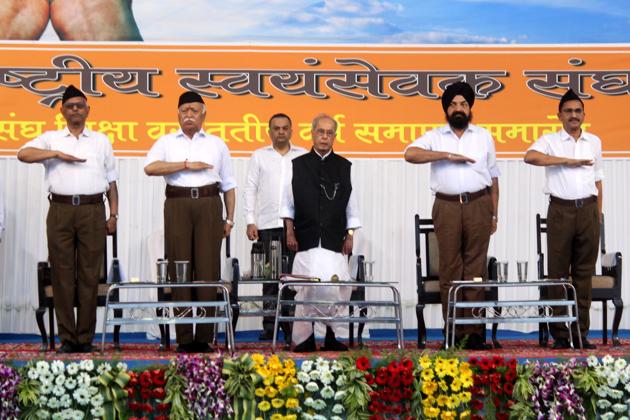One can understand the Sangh only from the Bharatiya perspective
To understand the organisation is not an easy task and it is certainly not possible to do so through a western perspective that thinks in binaries
The Rashtriya Swayamsevak Sangh (RSS) has always thought of itself as an organisation which touches all of society. This has not changed even after Independence. Hence in the constitution of the RSS, written soon after Independence, in 1949, it is clearly articulated that should a swayamsevak choose to enter politics, he is free to join any party. This constitution was written before the establishment of the Jan Sangh. Even after the Jan Sangh came into existence and despite the fact that many swayamsevaks and pracharaks were working for it, there has been no change in this provision. As we accepted democracy after Independence, there are bound to be several political parties in the country. Since the Sangh touches all of society, it is naturally expected that a swayamsevak, with his national perspective, would actively participate in every aspect of social life, including in the political arena. Hence, just because some swayamsevaks are active in politics, it is incorrect to say that the RSS is a political entity.

A political party stands for a particular ideology to which there will be a counter-ideology. The Sangh makes no such differentiations. Conceptually, the RSS and Hindu society are coterminus and psychologically they are one. Then how can the whole be a party to a part? It is important to understand this distinction.
In 1930, the Sangh’s founder, KB Hedgewar, along with some swayamsevaks and others, participated in the satyagraha movement in response to the call for civil disobedience by Mahatma Gandhi. Prior to his departure, Hedgewar handed over the reins of the RSS to Paranjpe and made it clear that he and other swayamsevaks were doing this in their personal capacity. As a consequence, he was sentenced to a year’s rigorous imprisonment.
Post-Independence, the then home minister, Sardar Vallabhhai Patel, suggested the merger of the RSS with the Congress Party. However Guruji respectfully turned down the invitation, stating that the Sangh wants to work as an organisation for all of society and not as a political party.
A few years later, SP Mukerjee approached Guruji and suggested to him that in view of the need for a political party with a right national perspective, the Sangh should fulfil this void. Guruji asked him to take the lead in this direction and offered the Sangh’s help.
In 1977, during the Emergency, the Janata Party won the elections in which swayamsevaks wholeheartedly participated. Many erstwhile parties had merged to form the Janata Party. Balasaheb Deoras, who was the Sarsanghchalak at the time, declined the offer of a merger saying that in a special, critical situation in national life, the Sangh took part in the election. But now it would concentrate on its destined mission of organising society.
In 2018, the Akhil Bharatiya Pratinidhi Sabha (ABPS) was held in Nagpur. On the invitation of the Sarkaryavah, veteran swayamsevak, MG Vaidya, attended it for a day. As he was 95 that day, he was felicitated by the Sarsanghchalak, Mohan Bhagwat. In response to this when he spoke, he said, “To understand the Sangh is not an easy task and it is certainly not possible to do so through the western perspective that thinks in binaries. One can understand the Sangh only with the Bharatiya perspective that is integral (ekatma).”
The fifth mantra of the Ishavasya Upanishad, while describing the Atma Tatva, the spirit that pervades everything animate and inanimate, says: Tadejati tannaijati taddure tadvantike/ Tadantarasya sarvasya tadu sarvasyasya bahyatah (The Atma Tatva moves and it moves not. It is far and it is very near. It is inside everything and it also is outside everything.)
Atomic scientists had once claimed that the atom is indivisible. Later, they stated that the atom is divisible and contains three particles: neutrons, protons and electrons. Further, they realised that it is not just three but that it contained multiple subatomic particles. Then they said that they are not just particles, they exhibit wave-like properties also. Then a theory came that it can neither be a particle nor a wave, it is both. It exhibits a dual character and was called duarticle. Eventually Heisenberg’s uncertainty principle came along which said that the position and velocity of an object cannot be measured exactly at the same time, even in theory and it arises in quantum mechanics simply due to the matter wave nature of all quantum objects. “The same thing is described in the Ishavasya Upanishad. If one understands this and the Bharatiya integral view (not the binary view) then only can one understand reality of Sangh,” MG Vaidya said.
Since we are now in the midst of the greatest festival of democracy, the general elections, the swayamsevaks will participate in public awareness campaigns to encourage people to exercise their franchise with an emphasis on issues of national significance.
Manmohan Vaidya is sah sarkaryavah (joint general secretary), Rashtriya Swayamsevak Sangh
The views expressed are personal






